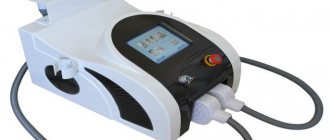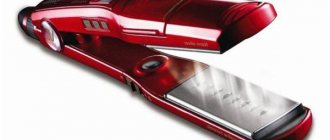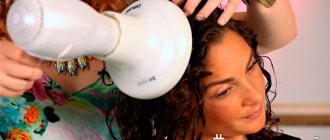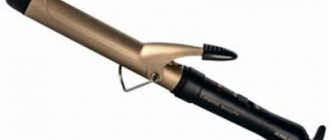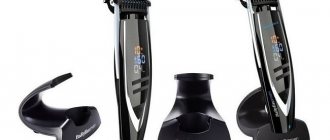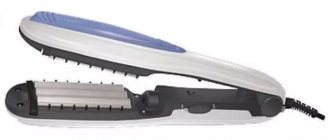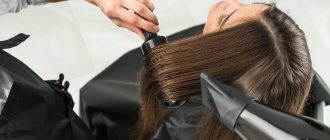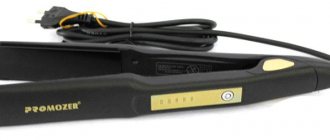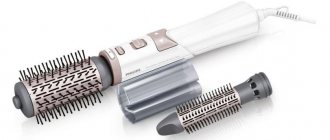Features of photoepilation
Photoepilation can be carried out in three different types:
- Elos – hair removal
This is a type of depilation that is performed on hair of different shades. The essence of the procedure is that the hairs are exposed to a light beam with an intensity of 45 J, and the bipolar radio frequency consolidates the effect. To avoid burning the skin, gel is first applied to it. The disadvantages of elos hair removal are that it is quite painful and you will have to undergo more than one session to consolidate the result.
- LHE – hair removal
During this type of photoepilation, the patient is exposed to a low-efficiency light beam (only 12 J). This does not cause burns to the skin, so no protective gel is used. The procedure is based on infrared radiation penetrating through the hair surface to the follicle and destroying the bulb. The advantage of the method is that unwanted vegetation is removed from a large area of the body, while little time is spent.
- IPL – hair removal
This type of hair removal involves exposure to high-intensity flashes of light with a power of up to 60 J. It is necessary to apply a special gel to prevent burns. The disadvantage of the procedure is that it does not remove gray hairs, and is also not applicable in the intimate area.
Step-by-step photoepilation process
Before the procedure, the cosmetologist determines the number of flashes and sets the device to the desired power. Further actions are as follows:
Stage 1
The client sits on the couch and puts on sunglasses that protect the retina.
Stage 2
The specialist applies a cooling gel to the skin. The product is necessary to prevent burns and protect the skin from high-impulse flow. The gel also helps to distribute light beams evenly over the surface of the body.
Stage 3
The device is applied to the skin and flashes are produced. The tip of the photoepilator is quite narrow and covers several square centimeters of area. Therefore, it will take 5 to 10 minutes to treat a small area of the face. Photoepilation of an arm or leg takes up to 20-30 minutes.
Final stage
The cosmetologist washes off the gel and applies moisturizer to the skin. The session has ended.
Photoepilation is considered a low-pain procedure, however, when treating the bikini area and armpits, unpleasant sensations may occur. Therefore, the doctor pauses between outbreaks to give the skin a little rest. During the session, he always asks how painful the procedure is for the client and, if necessary, reduces the power of the device.
Preparation for photoepilation
Photoepilation: “before” and “after” photos
Preparing for photoepilation involves undergoing an examination. First of all, you need to visit a dermatologist, who will not only examine the condition of the skin, but also identify possible contraindications. In addition, you need to determine your skin type. Next comes a consultation with a cosmetologist who will select the most effective and safe type of procedure in each specific case.
Stages of preparation for photoepilation:
- For 14 days, you should avoid tanning on certain areas of the skin (this also applies to solariums), stop taking antibiotics, tranquilizers or steroids (during photoepilation, the effects of such drugs are enhanced, which can cause significant damage to health)
- three days in advance, in the area where the manipulation will be carried out, all hairs are shaved off with a regular razor (for the intimate area or under the arms, this must be done 48 hours before exposure to light waves)
- On the day of photoepilation, you should refuse cosmetics and also not use moisturizing or nourishing creams.
The principle of photoepilation
The method involves the impact of light waves emanating from a special sensor on the hair shaft and its absorption of this energy. A “thermal effect” occurs in the subcutaneous tissue, that is, tissue heating. This leads to the destruction of hair structures at the molecular level.
The IPL method uses the principle of selective photothermolysis - the selective effect of light waves specifically on the hair pigment. But the skin, despite the fact that it contains the pigment melanin, is not affected at all. Unpleasant consequences occur only in extremely dark-skinned people or those with a strong tan. Having a tan and dark skin are contraindications for the procedure. The hairs under the action of the laser are heated to 80 degrees, at this temperature the follicle is destroyed (partial or complete). During a course of procedures, the bulb is deformed as much as necessary. This action helps prevent the growth of body hair, and also thins it and makes it lighter and more invisible.
Face
The most problematic areas on the face for women are the cheeks, chin and the area above the upper lip. The increased formation of “vegetation” on the face is influenced by hereditary factors and dishormonal disorders in the body (excess of “male” hormones).
Treatment of the upper lip, cheeks, forehead and chin is one of the most popular procedures to get rid of unwanted hair. Due to its high efficiency, this method has gained great popularity among women.
Before processing the antennae, a gel is applied to protect the skin from thermal burns. Subsequently, with the help of a special device that emits bright flashes of light waves, the hairs are “burned out” over certain areas of the face. To remove whiskers, only 5-6 such flashes are enough. During the procedure, many will feel a slight tingling sensation. But there shouldn’t be any severe pain!
Senas on the face lasts 15 minutes. A month later, the procedure can be repeated. To completely get rid of “vegetation” you will need 5-7 visits to the salon.
Armpits
Treatment of armpits lasts no more than 30 minutes. The number of sessions is 4–5, with a break between procedures of a month. The technique is the same as for facial hair removal - a sensor is passed over the area of the armpits, from which light flashes emanate. It is important that you should not shave your armpits between sessions, otherwise the entire effect of exposure to light waves will disappear.
Stomach
Epilation of the abdomen does not last longer than the work of a cosmetologist on other areas of the body. All manipulations will take about 20–30 minutes. The time depends on the area of the surface being treated. The break between sessions is 4–5 weeks. The procedure is completely painless for the client, however, mild tingling or tingling may occur.
The chest and abdomen area is no different from the general principles of preparation before going to the salon: do not visit the solarium or sunbathe two weeks before the procedures, do not use other methods of hair removal (including shaving or waxing). For a high-quality procedure, the length of the hair should be at least 2 mm.
Bikini area and deep bikini
Hair removal on the inner thigh and pubic area, despite the fears of clients, is a completely painless procedure. These methods are especially successful before the summer holidays. Deep bikini areas are treated in the same way as other methods of hair removal with an ipl laser. Most salons guarantee complete painlessness, but judging by the reviews of women, in some cases (women with hypersensitivity) unpleasant sensations may occur. Intimate photoepilation (removal of hair on the surface of not only the pubis, inner thigh, but also the labia, anus) is often called “Brazilian”. Cosmetologists recommend starting with a classic bikini, and then switching to a deep bikini to make it easier to get used to the procedure.
Legs
This zone has a higher cost compared to others, however, there is no fundamental difference between manipulations when removing hair on the lower extremities or when photoepilation of the abdomen is used. Hair removal occurs from the entire surface of the legs. But in almost all salons there is the possibility of hair removal of individual areas. For example, the area of the lower leg or thigh.
Typically, high-quality hair removal will require about 8 visits to a cosmetologist (or more when epilating the entire surface). The break between sessions is approximately 30 days.
How is photoepilation performed?
For some, one photoepilation procedure is enough to get rid of unwanted hair. But more often it is carried out in courses of several procedures to achieve a longer lasting effect and better results. On average, up to seven procedures will be required, which are carried out at intervals of at least 7 days. This depends on the skin tone and hair structure, which is determined by the cosmetologist.
Sometimes it happens that black hair begins to fall off already in the second session, but those with light brown hair will notice the effectiveness and efficiency of the procedure only after completing the full course. On average, 14 days after photoepilation, 75% of the treated area of skin disappears in girls with dark hair, and about 50% in blondes. This is due to the fact that fair-haired or fair-skinned girls have less melanin, which is why several more procedures will be required.
Home photoepilation
Today it is possible to do photoepilation at home. Some manufacturers have launched portable photoepilators on the market.
These devices differ significantly from those used in professional salons. First of all, the manufacturers made sure that the consumer could not burn himself during the procedure. Home devices have a much lower light energy output than professional equipment. Using a home photoepilator you cannot get rid of white, red and gray hair.
Using a home photoepilator you can treat all areas of the body
According to the manufacturers, after a course of procedures the skin remains smooth for 6 months.
You need to prepare the skin for photoepilation and care for it after the session in the same way as in the case of a salon procedure.
A home photoepilator is used as follows:
- First, remove all hair from the treated area using a razor.
- Then you need to determine your skin phototype. To do this, you need to turn on the touch recognizer on the device and bring the device to the surface of the skin. The photoepilator calculates the skin phototype and selects the optimal setting.
- You must confirm the proposed parameters or select the mode manually.
- If the design provides attachments for different parts of the body, you need to select the appropriate one and begin the procedure.
- After each flash, the device must be moved to another area, gradually covering the entire surface to be treated.
Each subsequent photoepilation should be repeated after 2 weeks. The course consists of 5 procedures. Then, to maintain the result, it is recommended to carry out photoepilation once every 4 weeks.
According to manufacturers, the duration of the procedure is:
- two drumsticks - 8–10 minutes;
- face (upper lip) – 1 min.;
- one armpit - 1 min.;
- bikini line - 1 min.
After 3-4 sessions, hair becomes smaller by 75-92% (depending on the photoepilator model and the physiological characteristics of the body).
Video: photoepilation at home
Recovery period
Photoepilation: “before” and “after” photos
Immediately after photoepilation, a special gel or cream is applied, which significantly moisturizes the skin and prevents the development of burns. You will need to use the product after the procedure, it will contribute to a speedy recovery. In addition, it is necessary to maintain water balance, since a large amount of moisture is lost as a result of manipulation.
After photoepilation, it is not recommended to visit baths and sunbathe for at least 4 days. During this time, both the skin and the water balance in it are usually restored. In addition, this will avoid swelling of the treated area, its peeling and significant redness of the skin.
To prepare for the beach season, girls should undergo photoepilation in advance, starting at the end of winter. In six months you can not only remove unwanted body hair, but also significantly improve the appearance of your skin.
How often is photoepilation performed and how long does the effect last?
How often should I do photoepilation?
The effectiveness of photoepilation is very high and after the first session, 30% of the hair is already removed. After 5-6 procedures, the skin becomes absolutely smooth and soft. How long the effect will last depends on various factors:
- Qualification of a cosmetologist
- How correctly the wavelength and penetration depth are determined?
- How modern devices are used?
- Does the patient have a hormonal imbalance?
On average, the procedure usually lasts from six months to five years. Hair on the arms and legs does not grow longer, and on the face the procedure will need to be repeated after 7-8 months.
Immediately after the procedure, you are unlikely to notice the effect, although, as we have already said, 30% of the hair is removed. You will be able to see this in about a week. To achieve a good effect, 4-10 procedures will be required. This is exactly what is required to get a good result.
The specific number of procedures depends on your individual characteristics. For example, people with fair skin and hair require fewer treatments, while dark-haired people with dark skin require more.
Advantages
Photoepilation: “before” and “after” photos
Photoepilation has many advantages:
- painless method with high efficiency
- the ability to remove unwanted hair, regardless of hair shade (the only exception is gray hair)
- minimal risk of infection as it is a non-invasive method
- low risk of burns and virtually no unpleasant consequences
Pros and cons of photoepilation, contraindications to the procedure
Photoepilation has a number of significant advantages, which force girls to resort to this procedure. So, the main advantages of the photoepilation procedure:
- short duration of the procedure, which takes 5-10 minutes (depending on the zone);
- reducing the likelihood of ingrown hairs;
- suitable for almost every area of the body;
- does not damage the skin;
- long-lasting results that last from several months to several years.
The peculiarity of photoepilation is that the maximum effect is achieved when dark-colored vellus hair is removed. Blonde, grey, coarse and long hair are less susceptible to flare-ups. To remove these types of hair, it is better to use laser hair removal method.
Despite all the advantages of the procedure, you should also indicate the disadvantages of photoepilation , including:
- photoepilation does not provide for getting rid of hair for life;
- high cost of the procedure;
- the procedure is painful (but this can be corrected with the help of special creams and other painkillers);
- the need for lengthy preliminary preparation for the procedure;
- photoepilation does not work on hairs that are too light and gray;
- the likelihood of getting burns (only if the specialist performing the procedure is not experienced enough or performs the procedure incorrectly);
- a large list of contraindications.
Naturally, such a procedure is not available to everyone. There is a list of contraindications for which the procedure cannot be performed. We invite you to familiarize yourself with it.
Contraindications to a course of photoepilation procedures:
- Skin diseases (psoriasis, eczema);
- Herpes in the active stage;
- Diabetes;
- Diseases of the cardiovascular system;
- Skin cancer;
- Hypertension;
- Colloidal scars;
- Pregnancy;
- Lactation;
- Fresh tan;
- Varicose veins;
- Tattoos on the epilated area.
We strongly recommend that you visit a doctor before undergoing photoepilation. This will protect you if additional contraindications to the procedure are identified. You can also learn more about a similar procedure called Brazilian hair removal.
Disadvantages of photoepilation
Despite its advantages, the photoepilation method also has its disadvantages, which are as follows:
- owners of blond hair will have to undergo more sessions than girls with dark hair (it's all about melanin, which blondes have less of)
- on tanned skin, photoepilation can cause burns or unwanted pigmentation (low qualifications of the technician or the equipment itself can also cause burns)
- The result of the procedure is not visible immediately, at least after two weeks
- if you do not follow the specialist’s recommendations regarding the recovery period, then peeling, swelling and redness of the area cannot be avoided
Why photoepilation is so popular: advantages and disadvantages
Photoepilation - the result
Although photoepilation is a popular procedure, it has both advantages and disadvantages. Among the positive ones, the following stand out :
- This method is highly effective because it targets the follicles and destroys them
- Photoepilation can be performed on any part of the body.
- The effect lasts a long time, but if the procedure is done regularly, then gradually the hair will stop growing completely
- The equipment allows you to adjust the wavelength, so you can remove any, even the deepest follicles
- There is no pain during the procedure
- The skin is not damaged during the procedure, and the filters do not allow burns to form
- The duration is only 20 minutes, so it can be done at any time
Disadvantages of photoepilation
As you can see, there are plenty of advantages, but there are also certain disadvantages:
- For blond or gray hair, the procedure may not be effective. This is due to the fact that the hair produces practically no melanin or very little
- There is a lot of hair on the body and each one is in a different stage of growth. Therefore, after one session it will not be possible to completely remove hair.
- Dark and tanned skin is especially sensitive to light, and therefore the procedure is carried out especially carefully.
- After the procedure, burns or age spots may appear. This happens when the device is either faulty or incorrectly configured
- When actively interacting with melanin, light pulses can lead to hyperpigmentation
- In rare cases, skin peeling occurs
The effectiveness of photoepilation
Photoepilation: “before” and “after” photos
Photoepilation is currently one of the most effective and gentle methods of removing unwanted vegetation. Scientists from all over the world have conducted a lot of research and proven that the effectiveness and efficiency of the procedure remains for many years. On average, hairs do not grow back for at least two years, but it all depends on the individual characteristics of the body.
Improved types of photoepilation
ELOS hair removal
Electro-Optical Synergy is a method of removing unwanted vegetation, which includes two types of activity - radio frequencies and light pulse energy. ELOS hair removal and photoepilation are not identical concepts, but they intersect. The effectiveness of radiofrequency radiation for heating hair is questionable. The method causes quite a lot of discomfort, and the effectiveness is on par with standard photoepilation. There is a danger of getting burns on dark skin. The hardware for ELOS hair removal is also developed from Israel.
Important ! These devices are especially popular.
ELOS hair removal
LHE hair removal
LHE hair removal (Light and Heat Energy) – simultaneous exposure to heat and light. The hair heats up not only due to light, but also due to heat. The light wave is scattered, and the temperature at the site of exposure increases. A mixture of inert gases is used, and radiation within the wave propagation range - 400-450 and 950-1100 (dangerous ranges) - is reduced, as is the risk of burns. The hair will not be permanently removed, but the amount of hair will be significantly reduced and the procedure will slow down its growth.
Important ! Hair removal is done on devices from the UK and Israel.
LHE hair removal
AFT hair removal
AFT (Advanced Fluorescence Technology) is a technique that uses filters that neutralize part of the spectrum. It turns into near-infrared radiation, which is not harmful. Waves operate at a length of 800-1000 nanometers. The likelihood of receiving unwanted effects is reduced. The use of technology will allow us to avoid maximum energy values; it uses a small fraction, but the impact of the pulses itself is greater. The implementation of therapy through Israeli devices with the In-Motion function makes the therapy short-term and comfortable.
Important ! This type of photoepilation is gaining momentum and gaining fame among people, but it is worth saying that it is not ideal, since it still has the same disadvantages (the need for a number of procedures, little effectiveness when treating blond hair).
AFT hair removal
Removing unnecessary vegetation certainly brings a good mood, but choosing the type of therapy to combat it is an important step. To date, there is no such procedure that could get rid of unwanted hair at once and forever. Only that part of the hair that is in the active growth phase is affected. A number of procedures are a necessary measure in order to have the opportunity to affect other hair, which will subsequently become active. When carrying out several procedures, it is necessary to take into account the characteristics of each person’s body: hair type, hormones, general condition. It is important to maintain intervals between procedures.
Important ! Each therapy is discussed and selected strictly individually.
You need to go through several procedures
Contraindications
Like any cosmetic procedure, photoepilation has its contraindications.
- The procedure can be carried out only 2-3 weeks after sea tanning or visiting a solarium. During this time, the skin is restored and burns do not occur.
- It is not used for people with diabetes mellitus, with heart pathologies, during exacerbation of chronic diseases, or with malignant neoplasms (especially on the skin).
- The procedure is contraindicated for pregnant and lactating women, as well as for those who have wounds, abrasions or tattoos at the site of photoepilation.
When you should not do photoepilation: contraindications
Photo hair removal - contraindications
Despite the fact that photo hair removal is suitable for any skin and hair, there are certain contraindications.
There are not very many of them, but they are worth knowing:
- First of all, the procedure cannot be carried out if other methods of hair removal have already been used on site. This does not apply to situations where simple shaving is carried out, but if you have recently had sugaring, waxing or laser removal, then hold off on the procedure.
- If there are wounds or abrasions, as well as inflammation in the hair removal area, the procedure is contraindicated.
- After prolonged exposure to the sun, the procedure is prohibited.
- If you have tattoos at the epilation site, it is not recommended to work on this area.
- Steroids, drugs that increase photosensitivity, and isotretinoin are contraindicated if you are taking them.
- It is not advisable to carry out the procedure during pregnancy and lactation.
- If the body has electronic devices, such as a pacemaker or insulin pump, then the procedure is not performed to avoid malfunctions.
- If you have had a history of sun allergies, SLE or porphyria, this will prevent you from undergoing the procedure.
Possible consequences
Photoepilation and its features
Side effects from photoepilation:
- the appearance of pigment spots at the site of exposure to light pulses
- burns and their further scarring
- peeling, swelling, bruising and significant redness of the light-treated area
- allergic manifestations
- increase in body temperature
These side effects can be avoided if photoepilation is carried out by an experienced specialist and only with high-quality equipment. Sometimes allergies and dermatitis on the skin can also occur due to the individual characteristics of the body. To avoid this, you should follow the specialist’s recommendations regarding preparation for the procedure.
How to prepare for photoepilation?
Preparing for photoepilation
Before going to the salon, a little preparation for the procedure is required. This is required in order to minimize the risk of complications and obtain the desired effect.
- A month before the procedure, remove hair exclusively with a razor. If you use other hardware methods, photoepilation will be prohibited.
- A couple of days before the procedure, you can shave the hair in the desired area. This cannot be done later, because for photoepilation the hair length must be at least 2 mm.
- Stop going to the beach or solarium two weeks before the procedure. This is because tanned skin is more sensitive to heat and can result in a burn.
- Do not use creams or other skin products before visiting the salon.
- If you are taking tranquilizers or antibiotics, then first complete the entire course and after a couple of weeks you can go for the procedure.
Alternative Methods
After photoepilation, side effects can occur only in two cases: the presence of a contraindication, as well as an incorrectly selected photoepilator mode and its intensity. People with sensitive skin should choose a different method for removing unwanted hair.
Alternative hair removal methods:
- regular razor
- sugaring
- waxing
Regardless of skin sensitivity, there are no side effects.
Prices
The cost of photoepilation depends on the number of pulses produced (light flashes), the level of the specialist, the specialized clinic or beauty salon, and the anatomical area where the client is going to remove hair. Average cost of the most popular procedures:
- armpit area - 2,500-3,500 rubles;
- complete legs - 20,000-25,000 rubles;
- area above the upper lip - 1,000-1,200 rubles;
- full hands - 6,000-7,000 rubles;
- deep or classic bikini - 3,000-7,000 rubles;
- shins - 14,000 rubles.
1 pulse for hair removal on the lower leg will cost from 60 to 80 rubles; in the bikini area, treatment is more expensive - up to 200 rubles. Men will pay 500-1,000 rubles more for the photoepilation procedure.
Is photoepilation harmful?
The photoepilation procedure may be accompanied by pain and discomfort, but this is purely individual and directly depends on the sensitivity and perception of each person. Before you decide to conduct a session of this type of hair removal, you need to carefully read the contraindications and rules.
Hair removal using a photo installation is safe, provided that all recommendations are followed. Use common sense, adhere to safety standards, contact a trusted professional and check the quality of the equipment. Much of this information can be obtained online. Then the photoepilation procedure will bring you extremely positive emotions.
If you want to find out more information about whether photoepilation is harmful and what the consequences may be after the procedure, we recommend
